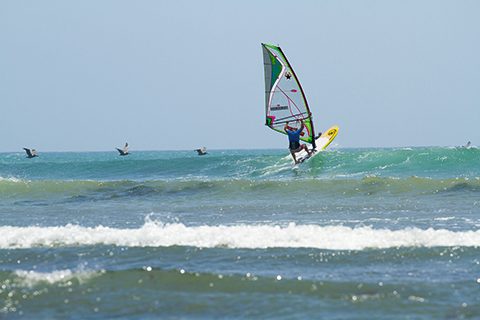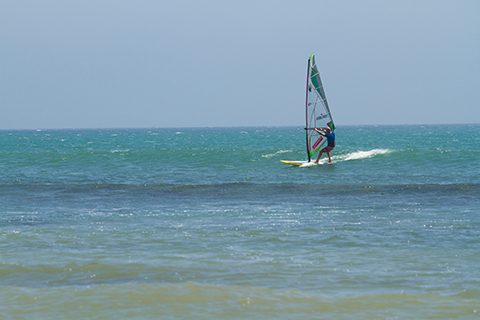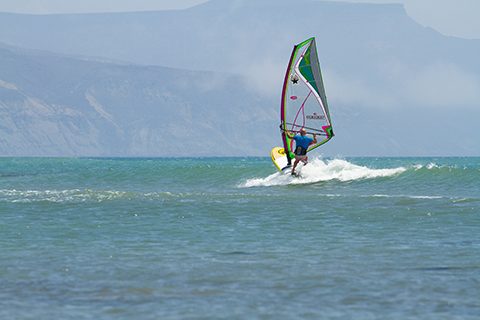JEM HALL
MOVE ON UP – WINDSURFING TECHNIQUE
WASUP – WAVE SUP’ING IN LIGHT WINDS
On my coaching courses I am constantly looking for ways to challenge my Rippers and help them mimic what I call ‘game time’, so they are better able to react more effectively and efficiently whilst under pressure.
Words Jem Hall // Photo Joey Sanchez
www.jemhall.com
(This feature originally appeared in the August 2016 issue of Windsurf Magazine. To read more features like this first, Print and Digital subscriptions are available. Prices include delivery globally for 10 x issues a year!)
I can safely say that from what I have seen of their responses to sailing WindSups, both in flat water and on waves, that these big beauties really do help people improve and give them access to a whole set of new conditions. I also have lots of extremely positive feedback from those who have bought and used WindSups (W’Sups) both for paddling and sailing on. Simply put they work! The most often bit of kit bought after a wave clinic? – a SUP. Why? Because my rippers reflect they need more water time and also they realise that dry, efficient tacks and gybes allow you to save more energy for riding and jumping when it is windy. WindSups also open up wavesailing to a wider spread of weights and abilities!
Ok, Ok I will stop beating the drum now but then I hear you ask ‘when will we use these W’Sups coach?’ Well, this is when it is too much wind to paddle in and not enough to waterstart, again both on flat water and in the waves! This month’s piece will give you the tools to enjoy light wind wavesailing on a W’Sup as well as extolling the virtues of it. The ideas for this piece came from 2 inspirations: one was from receiving a serious retune in my SUP (paddle) waveriding technique from Will Rogers, and thinking I should transfer this to W’Sup; and secondly I saw some of the rippers on my Punta San Carlos wave clinic just charging hard on the W’Sups, going for it and generally having a ball!
Crossing over – Paddle SUP to WindSup:
• Paddling around you can see a lot about where the waves break and where is best to catch them. The same goes when sailing around at slower speeds.
• Whilst paddling you get more time to chose what to ride and will actually get a lot of waves and again this is replicated on the W’Sup. These big beauties can catch heaps of waves.
• One of the biggest learning points was that you really have to scissor the SUP around and this is aided by moving your feet a lot and getting your back foot right back, and moving it from rail to rail whilst riding. You have to boss it around and this will really transfer to your wave board ‘riding’ too.
• Fitness: both sports give you valuable water time that will develop your balance, power, endurance and flexibility.
• Psychology: in both sports having and executing an experience learned game plan will yield more waves, fun, improvements and good times.
“ WindSups, both in flat water and on waves, really do help people improve and give them access to a whole set of new conditions ”

Open the sail and ‘ollie’ the board over the wave.

Get the SUP moving early to catch the wave.

Gybe, or tack, off the wave with an actual exit plan.
Get Out
My Sup paddle sessions have really improved my technique, commitment and balance in getting over bigger walls of water on the way out. Your W’Sup sessions will do exactly the same.
Main tips:
• To get out over white water you’ll need to get right back on the board, with a wide base, sheet out and ‘ollie’ over it – i.e. get low over the board, push down on the back leg and let the front knee soften.
• Try hitting the wave 5-10 degrees off straight at it, as you will inevitably head upwind going over the wave and in your recovery behind it too.
• Choose a good route, i.e. bearing away to avoid steep breaking waves, or heading upwind if this does not slow you down too much and means you avoid a ‘section.’
• Throw in a chicken gybe or tack if it is looking like you might not make
it out
• Look for opportunities to turn around and catch waves that look suitable to get a fun ride in on. This is all part of the ‘game plan’ that will get you to be a better wavesailor!
Catch
As you enjoy the view and eye up your waves on the way out you can relax on your big beauty, and you can also wait around at the ‘bus stop’ (wave catching zone terminology from my Winner to Wavesailor DVD). This puts you in a strong position to decide what wave you want to take back in, and when, and without too much energy expended. However, be aware that you need to turn around early if you are looking to get onto a wave as these beasts take a bit of time and you need to be ready to catch the wave in the right spot. Hammering down a wave clew first and trying to flip the rig is great fun, but mainly for the viewers on the beach!
Main tips:
• Bear away, unstick the beast and pump earlier than you think. You are going slowly and you need to replicate the wave’s speed!
• Pump not only at the right angle to the wind to get moving but also at the right take off angle for the wave. Patience grasshopper, all this experience will ‘Make You A Wavesailor.’
• Get speed and assess whether to take the wave upwind or downwind to best position for making some turns.
• Move your feet up and down the board to trim it and get that nose up if it is a steep drop.
• If you miss a good wave at the bus stop then be patient, turn around and get back out there and queue again nicely. Experience will teach you why to do exactly this.
“ WindSups open up wavesailing to a wider spread of weights and abilities! ”
Kit:
Your W’Sup should be a floater for you and this will mean around 8’0’’ to 10’0’’ so as to be throw around. (taking into account the new stubby style SUPs.)
Aim for 40-60 litres above your body weight.
Sail set should be a bit flatter if it is windier or fuller to pump into the wave if it is really light.
No harness is recommended to up your physicality, hand toughening and work rate if you are up to this.
Move your fin forward to loosen the board and ensure it is under 25 cms.
Use a big bit of rope at the back of the board for launching/landing. Keep your hands off this if you are getting washed and only hold the mast/boom for keeping a hold off the kit in the ‘washing machine.’
Ride
I have already talked about you bossing these ‘big beauties’ about and one of your many realisations of this will have already been whilst you ‘ollie’ out through the break. With a naked (without footstraps) board / W’Sup you’re free to move up and down it, same as for regular SUP’ing and longboard surfing, so really look to do this. Lightening your feet from pulling down on the boom will also help all areas of your windsurfing too.
Main tips:
• Your bottom and top turns will involve a lot of scissoring of the board from the back and ensuring that your back foot moves from rail to rail will really loosen up your turns.
• Bottom turns involve you moving back, scissoring and pushing through the toes of the back foot (on the rail) as the rig moves mainly across you and remains relatively open.
• For your top turn initiate them earlier than you think and get back on the board and on your heel-side rail. Really exaggerate opening the sail and looking out of the turn, as the wind is light it is too easy to oversheet the sail.
• The waveriding is more physical than you’d expect and fun, fun, fun. You can even throw in some one-handed top turns to ensure you are moving your hands!
• When you eye up a section get the nose high out of the water and be aggressive. It really is a great rush, and even in waves/conditions that are not that rad. I dare you to go for an off the lip.
Get off
Exit plans are very much required in wavesailing and SUP’ing and I berate all my rippers for not finishing off their great rides with a sound strategy and technique.
Options:
• Scissor gybe off the end of the wave or off a less steep section.
• Or just come further in front of the wave, gybe back into it and go over it clew-first, step gybe style.
• Or you can duck-gybe off it if you’re looking to add this skill to your moves that matter.
• Or go upwind in the white water and then let that wash underneath you. Straighten up the board to get a bit of speed and then tack or heli tack to head back out.
• Do not get off and stroke your kit and pretend to adjust your harness lines!
Keeping busy
As you are enjoying the relative serenity of the session in these lighter winds and atop your big beauty, you actually have time to do moves between breaks in the waves, i.e. between the sets.
You can, and should, work on getting in lots of tacks, gybes, duck gybes, front-to-sail and heli tacks (working on your moves that matter) while you wait for your chosen wave to take you in. You are also able to just have a breather after your ride and getting back out to the surfline – hold on to the boom near the mast, let get of your back hand and take it all in.

All the points in this article will help you be better in float and ride which we will look at next month.
5. Your sail should be open here and moving forward. Remember to bring your weight back, ready to drop and turn again.
4. Carve harder through the heels now and look to bring the rig forward and open. Turn through, carving & scissoring your legs!
3. Head looks out of top turn as you move outboards and bring hands together.
2. Subtle change here as the rig is moving across & opening up as your hips move across, ready for an early rail change.
1. Drop down the wave for speed and move your weight back, carving hard over the toes of the back foot with your backhand and foot way back. Scissor legs to aid steering.
Conditions:
Side shore to side off is best for easier more drawn out turns and ease of getting onto more waves.
Side on winds can be fun but this requires tighter more challenging turns and it can also be harder to pump onto the wave at the right angle.
“ Lightening your feet from pulling down on the boom will help all areas of your windsurfing ”
RRD boards, wetsuits, softwear, Ezzy sails and Pro Sport Sunblock sponsor Jem Hall. Get him live and direct on one of his highly acclaimed coaching holidays. You can also follow him on twitter / Facebook and Instagram.
www.jemhall.com



